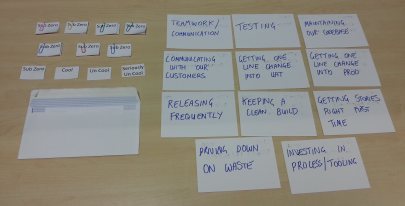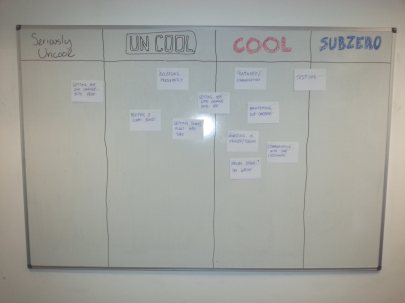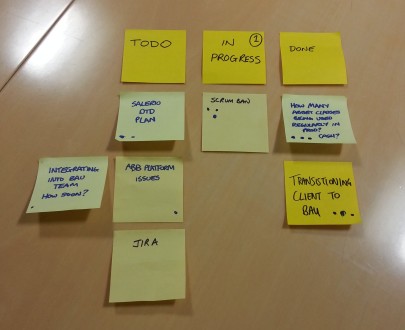Sprint Retrospective Techniques 2
A year ago I published a post on Sprint Retrospective Techniques that I employ to help my team to continuously improve. Since then I have tried out many other techniques to keep things fresh for the team. In this post I present three more simple techniques I have found to be especially effective.
Technique 1 – The Cool Wall
The Cool Wall is my favourite retrospective technique at the moment as it is not only very effective but also a lot of fun. I discovered it while browsing blog posts on the web looking for new retrospective techniques to try out. I am a fan of the UK motoring show Top Gear and this technique is based on an occasional segment from the show, “The Cool Wall“.
In the show the presenters Jeremy Clarkson and Richard Hammond decide how cool various cars are by placing pictures of them in various categories labelled: “Seriously Uncool”, “Uncool”, “Cool”, and “Sub Zero”. The show involves audience participation but ultimately the presenters (especially Clarkson) decide how cool each car is (usually overriding the audience).
For the retrospective version of The Cool Wall the cars are replaced by cards that represent positive practices or behaviours that the team engage in. For example, ‘Continuous Improvement’, ‘TDD’, ‘Listening to Customer Feedback’, etc.
The Scrum Master plays the part of the presenter while the team take on the role of the studio audience. For each card the Scrum Master asks the team:
“How cool are we at…<thing written on card>”
The better the team decides they are at the thing written on the card the cooler the category they agree to place it in. The Scrum Master then places the card on the board in the agreed “coolness category”. The most important difference between the retro technique and the TV show (and the reason it works as a retro technique as opposed to as entertainment) is that the audience/team decide on “coolness” not the presenter/Scrum Master.
The technique requires a little preparation. Beforehand the Scrum Master should prepare the behaviour/practice cards. The content should be topical to the particular team and their current circumstances. I also create small voting cards for each “coolness” category to allow the team to efficiently vote rather through the yelling and shouting that happens in the TV show. This also prevents the team from aligning themselves with the first vote that is shouted out.
The next step is to draw the cool wall on a large whiteboard complete with the headings “Seriously Uncool”, “Uncool”, “Cool”, and “Sub Zero”:
The session proper can now begin. The Scrum Master produces each card in turn and asks the team how cool they think they are at what is written on it. The team use their voting cards to display their choice. If there are wildly differing opinions on “coolness” then discussion can ensue until some consensus is reached. At this point the Scrum Master places the card on the board in the appropriate “coolness” category and moves onto the next card. Just like in the show it is permissible to place a card between two categories where agreement cannot be reached. This voting and discussion process proceeds until all cards have been placed on the Cool wall:
With all of the cards on the board it is time to move onto the next step. One card at a time the team discuss the things they are “Seriously Uncool” and “Uncool” at doing and identify corrective actions to improve their “coolness” at doing the thing on the card. I tend to write the key points of the discussion and any corrective actions onto the board as we go for future reference:
Technique 2 – Lean Coffee
I have written about Lean Coffee before in reference to the Lean Agile Glasgow meetups. Lean Coffee is a great technique for democratising meetings which is also suitable for retrospectives. The democracy comes from the team providing the topics and prioritising them for discussion.
While I allow an hour for most retrospective sessions I run I find that a Lean Coffee retrospective session requires up to two hours for a full discussion of the most important topics to take place. It is also the only type of retrospective that I run with the team sitting down as it does not require the use of a board.
The session follows this format:
- Everyone takes a few minutes to write up one or more stickies with topics they would like the team to discuss in the retrospective.
- Go through the stickies one by one with the author briefly explaining their question or topic (one minute should suffice for each).
- Everyone dot votes on the topics they most want to discuss. Each attendee gets three votes to spend – they can put multiple votes on any one topic and can vote for their own topics if they so wish.
- A Personal Kanban is created with three columns: To Do, In Progress, Done. The In Progress column is WIP limited to 1. Stickies are used to create the headings (see picture below).
- All topics are placed under the To Do column in priority order according to the number of votes they have received.
- The top topic is moved from To Do to In Progress.
- A 15 minute discussion ensues around the topic. A smart phone is handy to do the timing. If discussion around the topic dries up before the 15 minutes are up then progression to the next step comes early. Any corrective actions that are raised during the discussion should be noted down for agreement at the end of the session.
- The topic is moved to the Done column and the next To Do topic is moved to In Progress.
- Repeat from step 6 until the session time or topics are exhausted.
Technique 3 – Questions Retrospective
The final technique is the Questions Retrospective. The format involves posing a series of question to the team about how things have gone from their perspective. For example, here are some questions which I have gleaned from various sources and that I think make for a good generalised set:
- What Worked Well?
- What Should We Do Differently Next Time?
- What Did We Learn?
- What Don’t We Understand That Needs To Be Clarified for Future?
- What Made You Mad?
- What Made You Laugh?
You can target specific topics by introducing specific questions to address them, for example, to explore an event, good or bad, that has occurred in the preceding sprint.
Note that while this technique works well for sprint retrospectives I find it to be especially powerful for project retrospectives where a longer period of time is being considered. All of the pictures below were from a recent project retrospective I ran hence the sheer number of answers that were given.
In preparation for the session I send out the questions to the team in advance to encourage as much feedback as possible. In the case of a project retrospective I do this several weeks in advance. I also encourage the team to bring any answers they have pre-written on stickies so that ideas they have before the session are not lost and to speed the session up a bit.
Immediately before the session starts I write all of the questions onto a large white board:
When the team members have all arrived the session can proceed:
- Explain the meaning of the questions to the team and provide any necessary clarifications so that everyone is on the same page
- Encourage the team to place stickies with their answers under each question
- Wait until everyone has posted all of their answers. Team members can post as many answers to each question as they like
- Go through each question one at a time
- Have the team group similar answers to the particular question together into common themes
- Discuss each grouping one at a time identifying and recording any corrective actions
You Can Never Have Too Many Techniques
Keeping retrospectives engaging, and therefore effective, requires constant work on the part of the Scrum Master. Having a static set of techniques, however tried and tested they may be, is not enough and we have to keep innovating. I find I have to constantly seek out new techniques to accomplish this. Fortunately Agile practitioners are a generous bunch and new techniques are constantly being published on their blogs.
I have not been taken with every technique I have read about or gone on to try out and frequently make my own small adaptations to those I do use to increase their effectiveness for my team’s particular circumstances. This amounts to quite a lot of work but the rewards in the form of continuous improvement are worth it.
Perhaps in another year’s time we’ll see the publication of Sprint Retrospective Techniques 3.
Explore posts in the same categories: Agile, Scrum
Tags: Agile, Lean Coffee, Retrospectives, Scrum
You can comment below, or link to this permanent URL from your own site.






June 12, 2013 at 1:24 pm
Very useful! I have tried techniques 2 and 3 and now I’m going for the first! Thanks for the valuable resources!
April 24, 2014 at 2:41 am
Thanks for the tips. I will use this in my next retrospective with the team 🙂
March 24, 2015 at 4:21 am
[…] immer bei der gleichen Person lag. Ein anderes Team beschloss aufgrund der Ergebnisse aus einem Lean Coffee zu verschiedenen Themen, weitere Retrospektiven zu spezifischen Fragen im Zusammenhang mit […]
January 15, 2016 at 9:34 am
[…] the team to think about the previous sprint from a different angle. I came across the cool wall (https://waynedgrant.wordpress.com/2013/04/21/sprint-retrospective-techniques-2/). I felt that the team would enjoy this technique and respond in such a way that we would be able […]